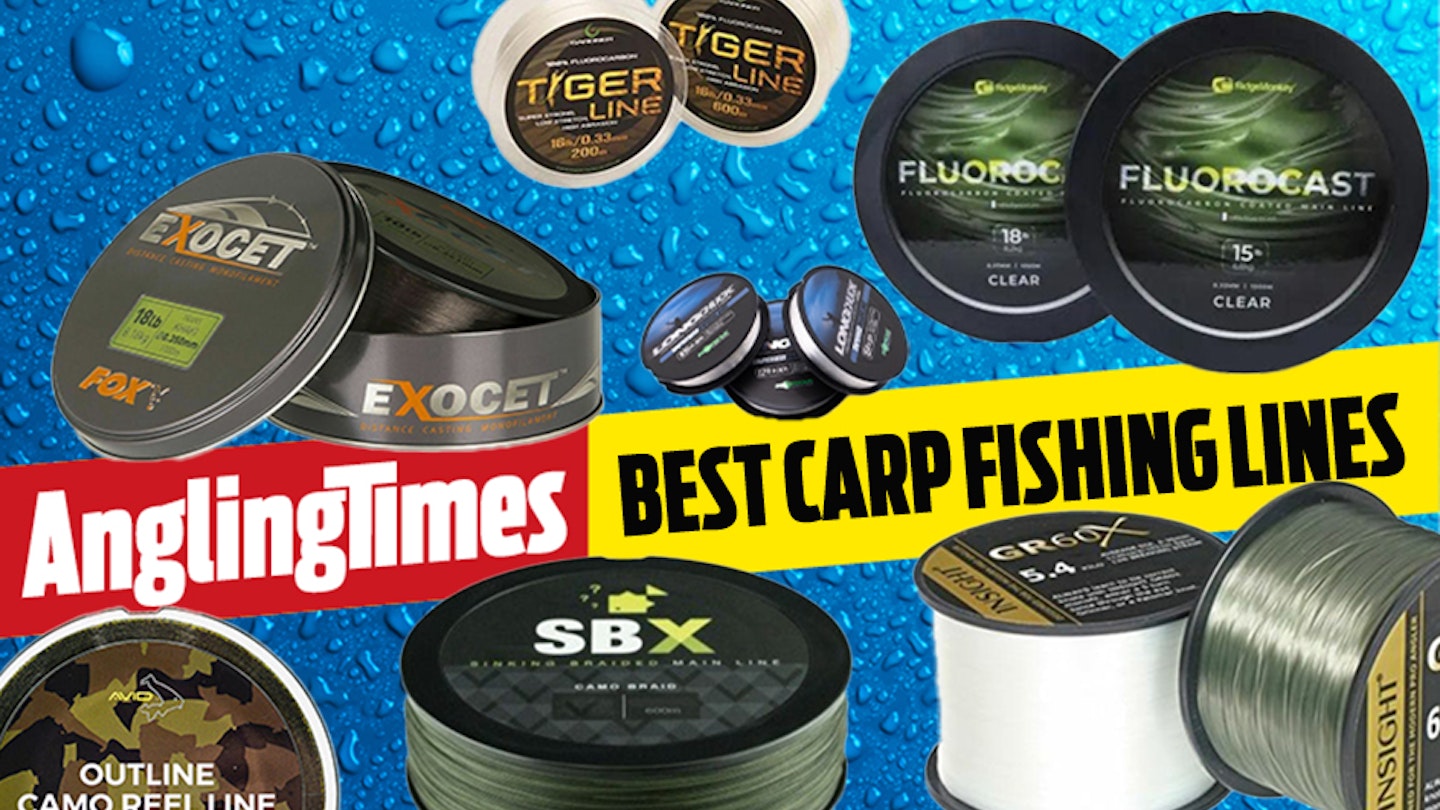Modern day carp fishing presents such a diverse range of scenarios that choosing the best line to use can vary hugely, and as such, there are so many different options to choose from. A lot of anglers don’t really pay much attention to their line choice, with many just choosing a line by its breaking strain. However, line can massively improve or impair your angling depending on the line you choose and the scenario you’re using it in.
Line choice can impact your ability to cast a long way, it can reduce or enhance your feeling of what the lakebed is made up of and it can also cause you to lose fish if it unsuitable for the situation you’re using it in. Some lines come with smooth coatings and low diameters to help you hit long distances, others are very thick and durable to help pull fish through weed, and then there are more specialised lines like fluorocarbons and braids.
The best carp fishing lines at a glance:
• Best Tapered Carp Fishing Mainline - Korda Longchuck Tapered Mainline - View offer on Fishing Tackle and Bait
• Best Fluorocarbon Carp Fishing Mainline - Gardner Tiger Line - View offer on Total Fishing Tackle
• Best Carp Fishing Mainline For Distance Casting - Fox Exocet Pro - View offer on Total Fishing Tackle
• Best Floater Fishing Line - ESP Synchro Surface XT - View offer on Total Fishing Tackle
With so many lines to choose from, it can be daunting for even the most seasoned angler to decide on the best line to use. But fear not, as this guide will show you some of the best available, when to use them and how to get the best from them…
Best carp line for fishing in weed
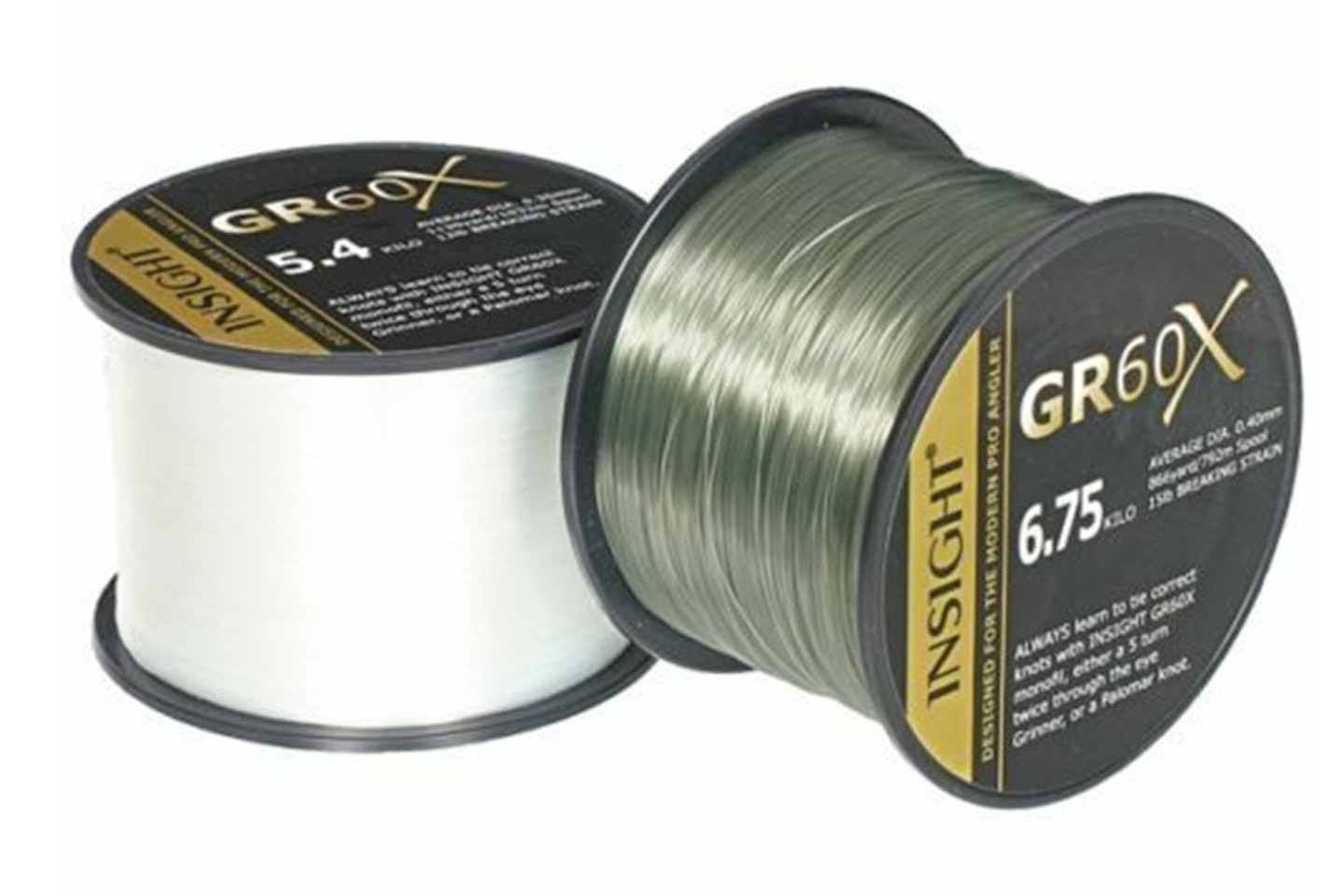
www.total-fishing-tackle.com
The premium Gardner Insight GR60X line lends itself well to demanding fishing situations, such is its mega abrasion resistance, yet it casts and sinks really well too, thanks to its uniform diameter and spooling. Available in clear or green, and in 10lb, 12lb and 15lb breaking strains.
It’s bullet-proof nature and ease-of-use make it a great choice for the carp fishing fraternity and big-fish specialist anglers, giving you the confidence when you're attached to that dream fish, it won't let you down. Great for fishing in weed or where the line will be put under severe strain during the fight, it's very durable, so it can take a lot of punishment before it gives out.
Pros
- Very strong.
- Super abrasion resistant.
Cons
- Not the best for long casting.
| Breaking strain: 10lb (0.30mm), 12lb (0.35mm), 15lb (0.40mm)<br>Spool Size: 1/4lb spools<br>Colour: Green or clear. |
Best hybrid carp fishing line
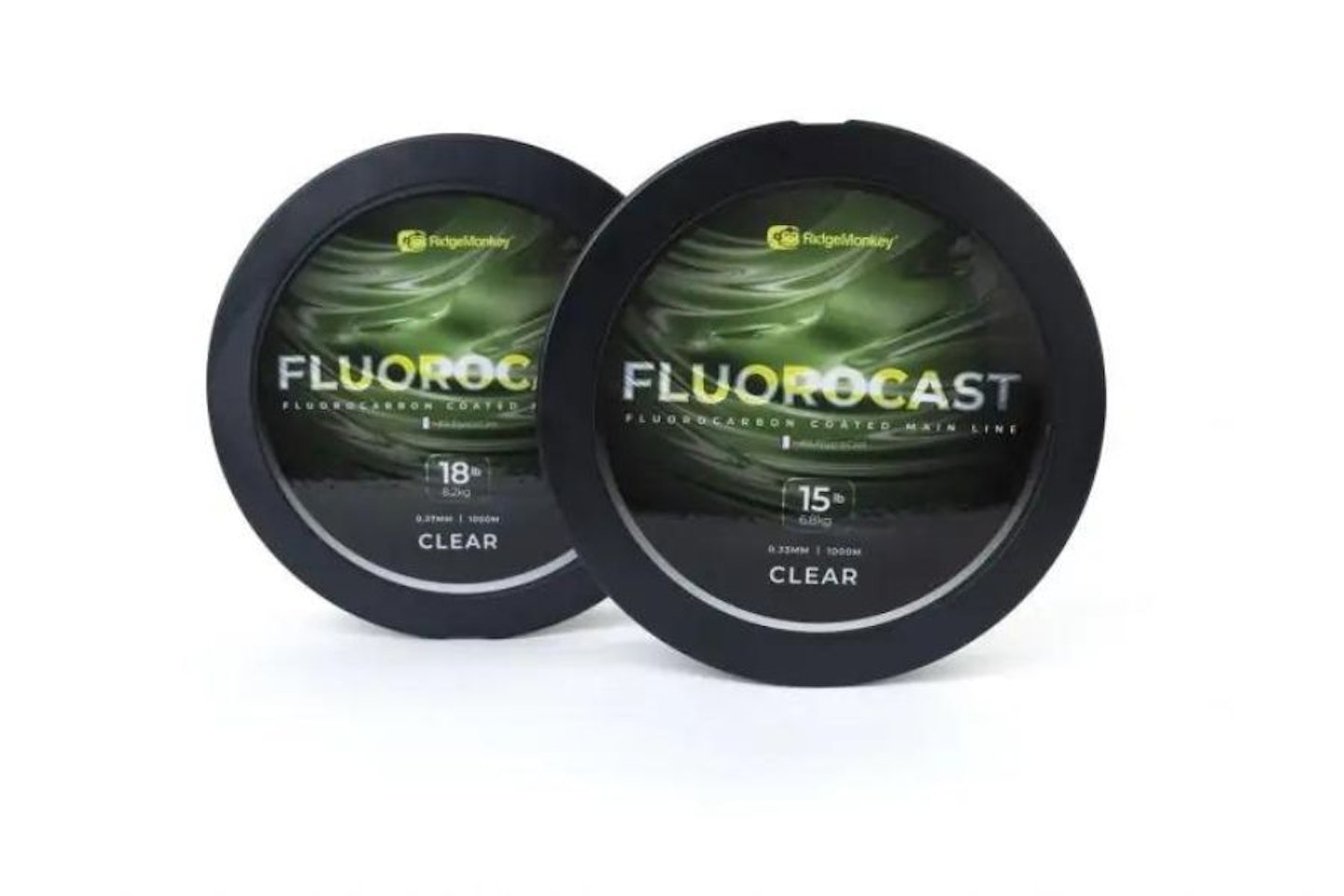
www.total-fishing-tackle.com
The Ridgemonkey Flurorocast is a new style of hybrid line between a fluorocarbon and a monofilament. Ridgemonkey have taken a great quality mono and added a fluorocarbon coating to give all the additional benefits but remove the issues that fluoro can cause to the angler.
Flurocarbon is famed for its ability to sink like a brick and for being practically invisible when submerged in water, however, it is quite wiry and thick, which will reduce casting distances. This RidgeMonkey coated line, however, is very supple and limp, and has a very low diameter for its breaking strain of 0.33mm in the 15lb. With these properties, it performs like a distance casting mono, whilst retaining the benefits of the fluoro.
It has a very low stretch, which improves the response when you feel the lead down onto the spot, even at range. It is also very strong and works from the first session out, it doesn’t need bedding in or stretching like some lines to start performing at its best.
Pros
- Great hybrid-style line, performs like a mono with the benefits of fluorocarbon.
- Sinks well and is practically invisible.
Cons
- Only available in 15lb and 18lb.
| Breaking strain: 15lb (0.33mm), 18lb (0.37mm)<br>Spool Size: 1000m<br>Colour: Clear |
Best carp fishing monofilament for concealment
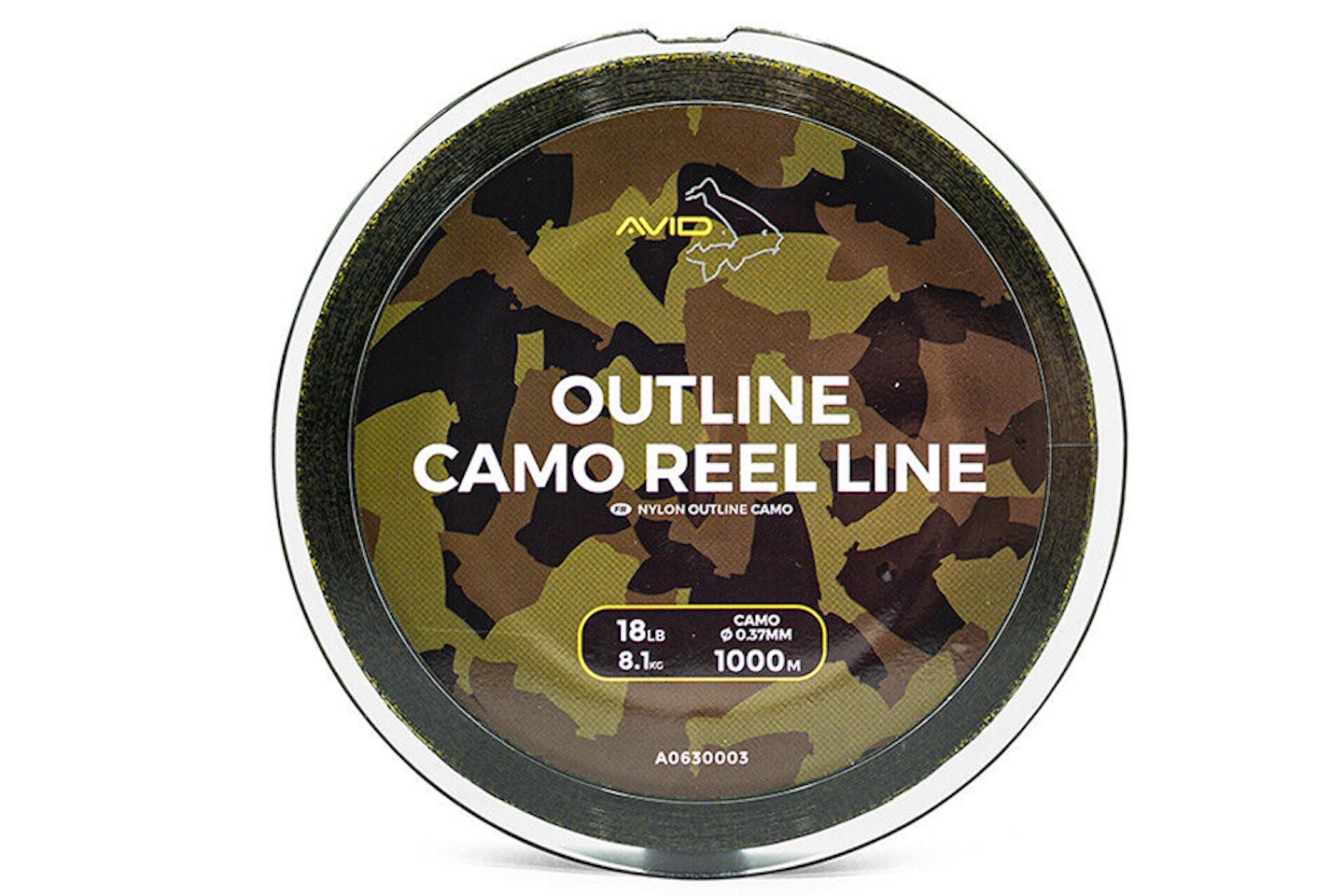
www.ebay.co.uk
The low visibility green colour interspersed with the darker micro-flecks of the Avid Outline Camo help break up this line’s profile underwater. Avid have got this just right, even when you drop the line in the margins it seems to just melt away, not quite as good as a fluorocarbon, but it is as good a concealment as you'll see in a mono.
It's not just a good camouflage though, the line performs really well in the other areas you would want it to. The line is incredibly tough, lending itself to fishing in weed or snags, where you will be putting huge amounts of pressure on the line. It has a very high abrasion resistance too, so even during long battles in the weed or if it has been on your reel a while, it won't deteriorate very easily. If you're fishing on lakes in the UK where you want to keep the line away from wary fish, don't want to use a fluoro and there are potential dangers to lose fish, the Outline Pro is an optimal choice.
It can be tad springy in its heavier grades/diameters, so don’t overfill your spool. Other than that, the more you use it and the more it gets stretched out, the more manageable it becomes.
Pros
- Camo finish.
- Fantastic strength.
Cons
- Can be a bit springy to start with.
| Breaking strain: 12lb (0.31mm), 15lb (0.33mm), 18lb (0.37mm)<br>Spool size: 300m and 1000m<br>Colour: Camo |
Best beginner carp fishing line
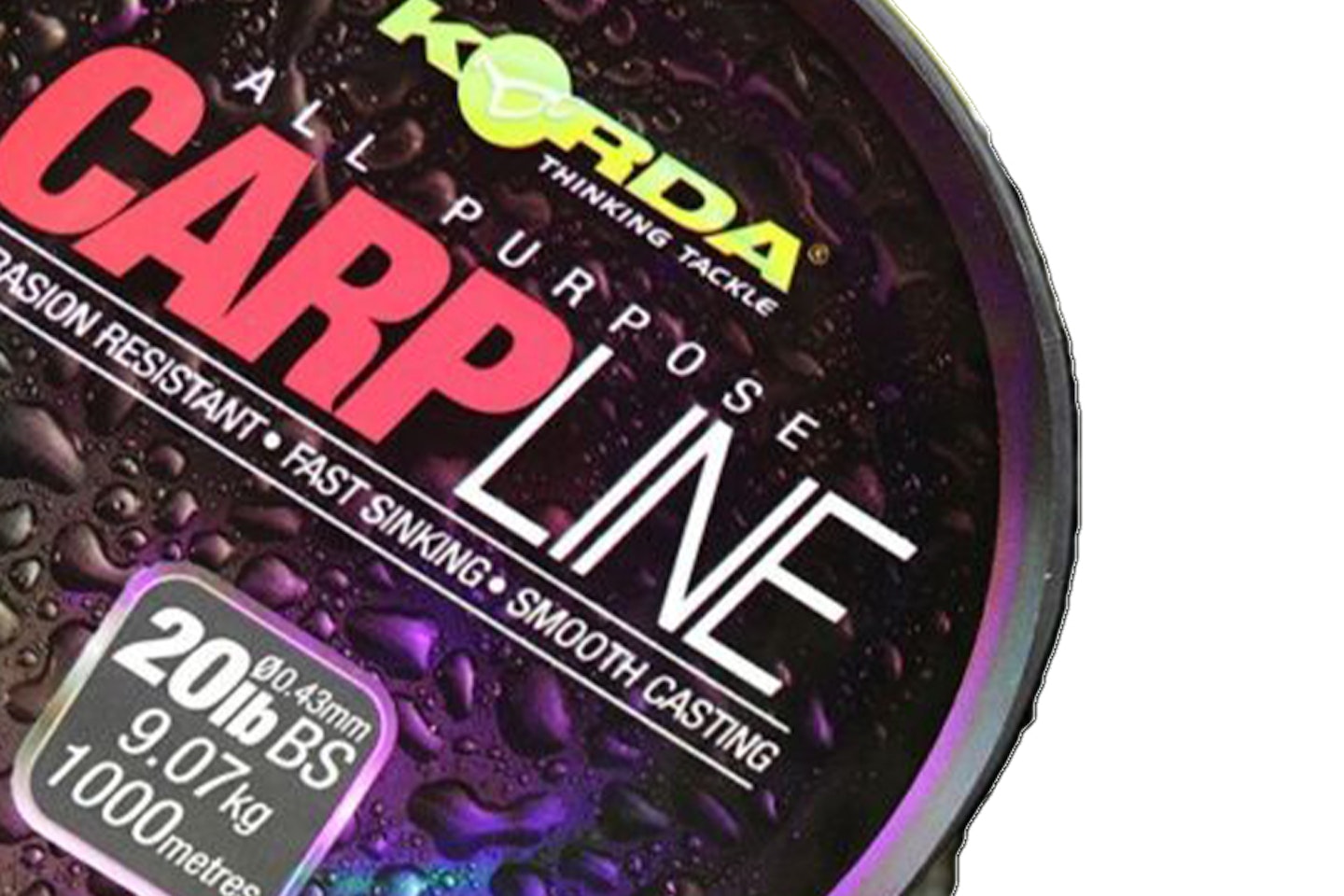
www.fishingtackleandbait.co.uk
As "tough as old boots" and sinks reasonably well, the Korda Carp Line blends in with most lakebeds thanks to its green colour. In breaking strains from 8lb to 20lb, it makes for a great beginner line or for fishing upto snags or in weedy situations due to its abrasion resistant qualities.
It is a good option if you're not really sure what style of fishing you'll be doing over the season, as it will perform well in a range of scenarios. If you only have one spool with your reels and are on a budget, this line will cover most of the UK angling situations you're likely to face, so you'll never turn up somewhere and not be able to fish effectively.
This line seems to get better the more it’s fished with. There are possible line management issues with heavier/thicker diameters, however. As it is a cheaper line, always soak for 24 hours before you spool it onto your reels, this will help take the twist out and it will bed down better on your spools.
Pros
- Very durable.
- Great value bulk spools.
Cons
- Not as user friendly as some lines to begin with.
| Breaking strain: 8lb (0.28mm), 10lb (0.30mm), 12lb (0.35mm) 15lb (0.40mm), 20lb (0.43mm)<br>Spool Size: 1000m<br>Colours: Green |
Best carp fishing mainline for distance casting
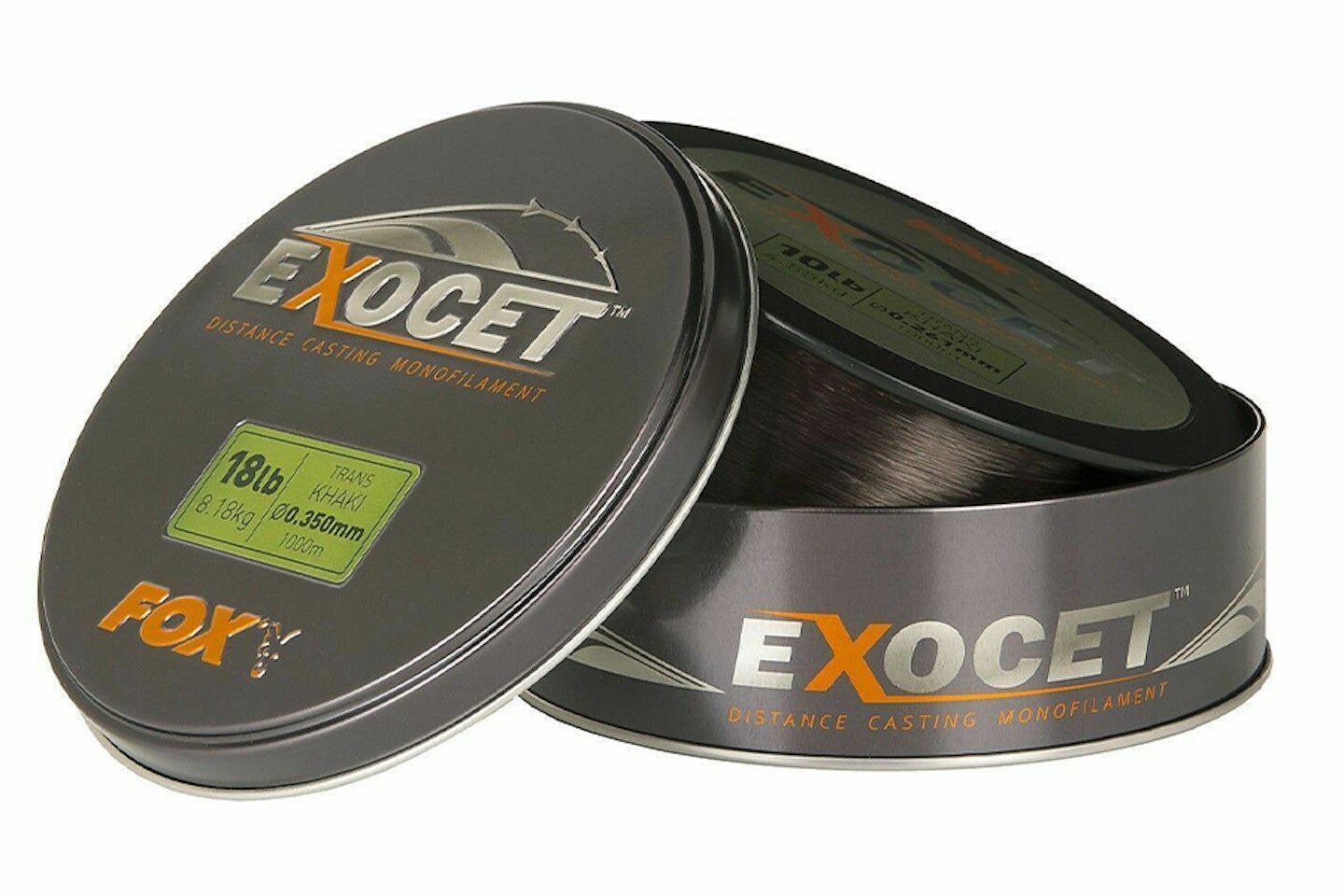
www.total-fishing-tackle.com
Fox Exocet Pro mainline has been designed to be used for distance casting. With many of the lakes now being pressured in the UK and abroad, the fish will naturally migrate to the centre of the lake to escape the angling pressure, which can call for a very long cast.
This line is a very limp and supple line with a low diameter profile, this helps keep friction to a minimum when it is flowing through the eyes of the rod, which in turn helps you hit those longer distances far more efficiently - in situations where those extra yards count, it makes all the difference. As such, it is a great choice for anglers looking for a mono to cast to the horizon with and is available in breaking strains from 10lb up to 20lb, covering any scenario or size fish you're likely to encounter.
A Lo-viz green colour was proven by underwater filming to be the best colour Fox could use to make it as invisible as possible for a monofilament line. Exocet Pro is very durable too, which is important when you consider you may have over 150 yards of line in the water that could potentially get damaged when fishing at range.
Pros
- Great for distance casting.
- Lo-viz colour blends in great with most lakebeds.
Cons
- Only available in 1000m spools.
| Breaking strain: 10lb (0.26mm), 13lb (0.30mm), 16lb (0.33mm), 18lb (0.35mm), 20lb (0.37mm), 23lb (0.40mm)<br>Spool size: 1000m<br>Colour: Khaki |
Best carp fishing braid
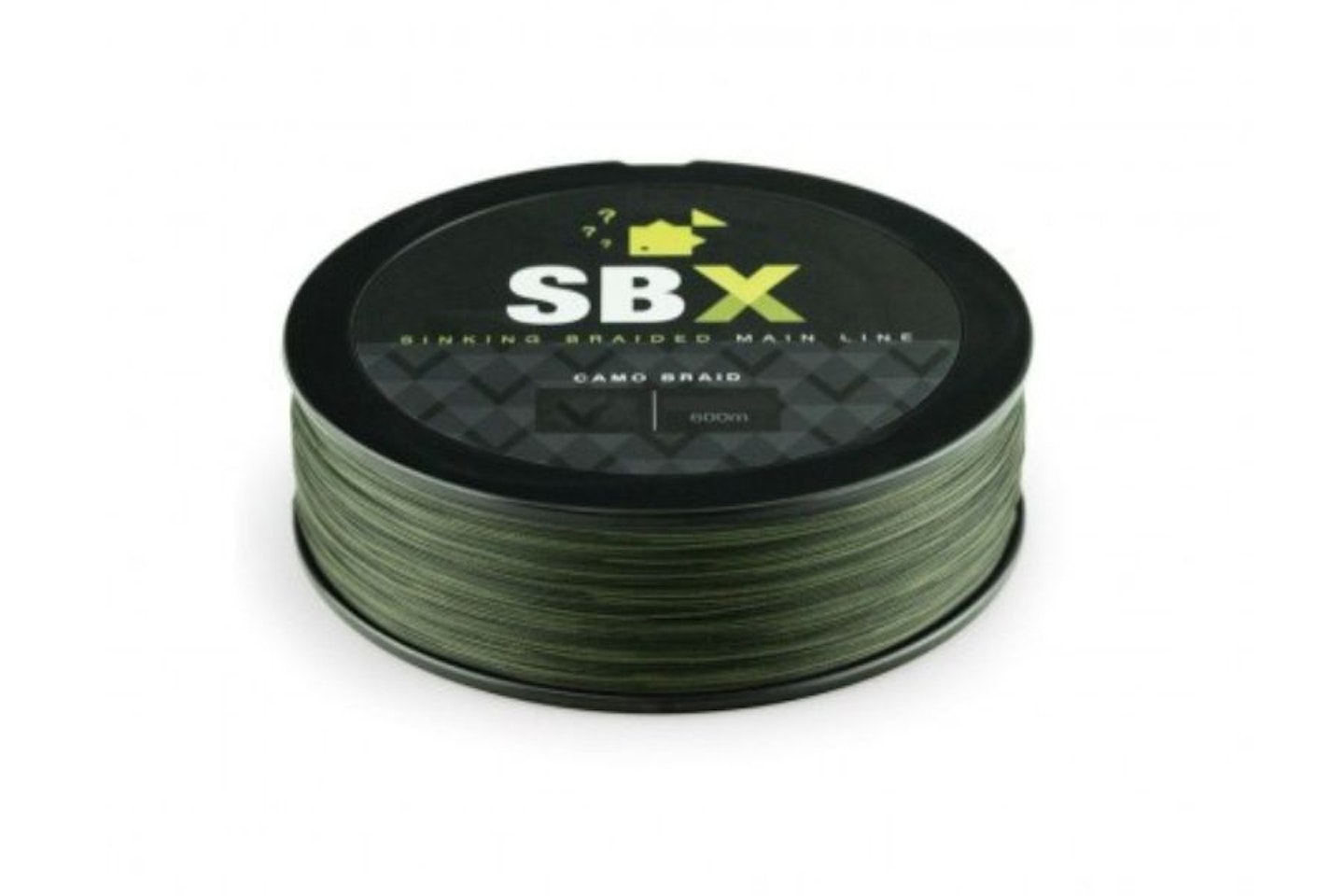
www.ebay.co.uk
When it comes to knowing what bottom you’re fishing over, braid really comes into its own, and the Thinking Anglers SBX Braided Mainline is a really good choice. The problem anglers often find with braid is it gets wind knots in it, it's not always the best to cast and it doesn’t sink all that well. However, Thinking Anglers have managed to overcome some of these problems with their SBX braid.
The braid is tightly woven to give a very fine diameter, with the 40lb version only 0.33m. The tight weave and round profile makes the braid very smooth, which not only helps with casting, it also prevents the braid knotting up on the cast as it won’t twist during flight. SBX has a number of fast sinking fibres to help negate the issue of the braid floating and it does sink, very well in fact, at times you forget it’s a braid.
As there is zero stretch in the braid, there is nothing more accurate for revealing what you’re fishing over. It helps makes sure that you are hitting the exact spot you want to. It completely eliminates the stretch and swing back mono can suffer from, which can alter where your lead lands depending on power and where you hold the rod when hitting the clip.
The SBX braid is also very tough, great for fishing in weed, as it can help cut through the strands to keep the fish moving and its durability means it will last years on the reels - if anything it will get better with usage.
Pros
- Very durable.
- Zero stretch offers unrivalled accuracy.
Cons
- Banned on a lot of waters.
| Breaking strain: 40lb<br>Spool size: 300m or 600m |
Best fluorocarbon mainline for carp fishing
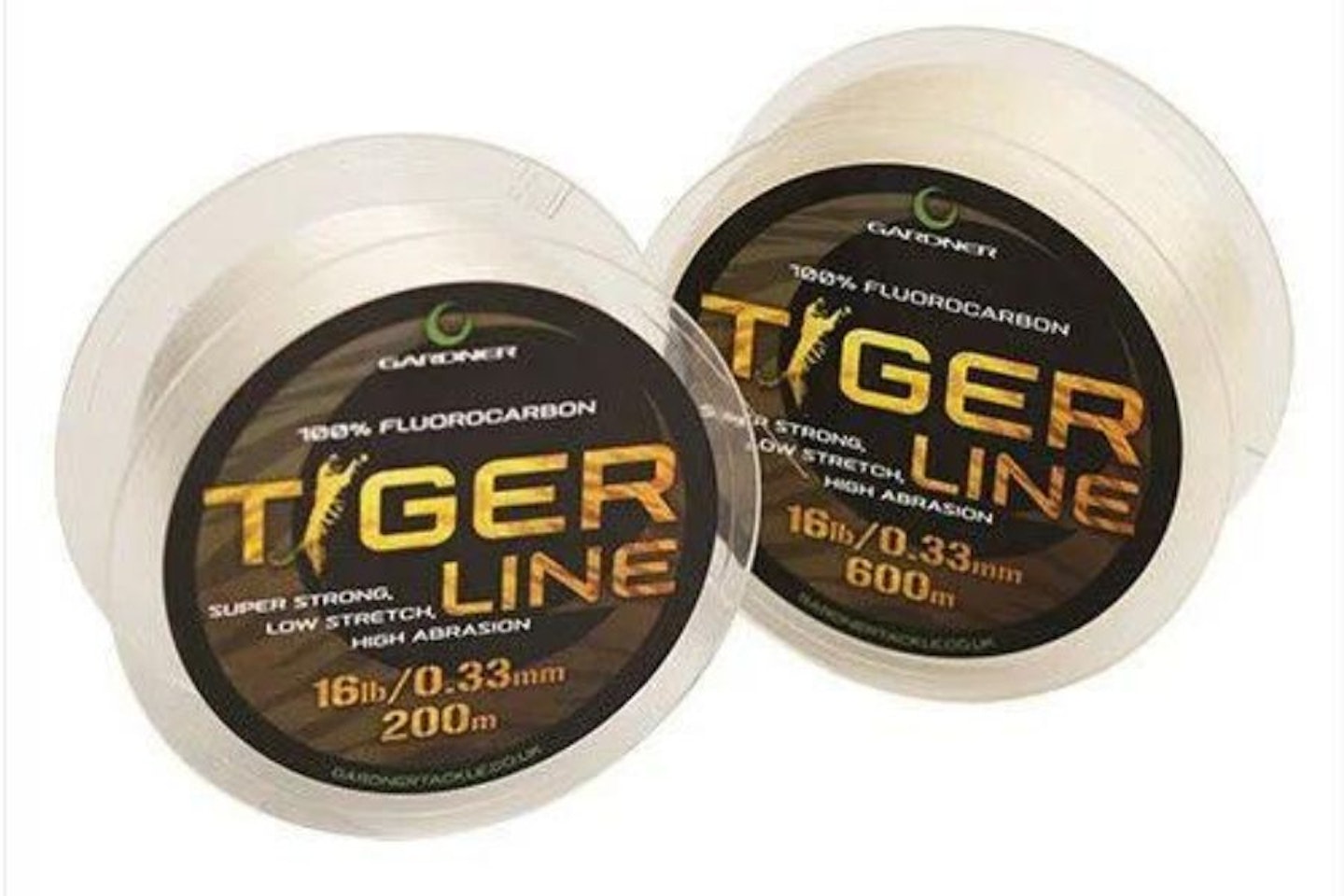
www.total-fishing-tackle.com
Tiger Line has had a huge following since its release by John Llewellyn a few years ago, that same product is now being produced and distributed by Gardner Tackle as Gardner Tiger Line. This multi-directional polymer, 100% fluorocarbon is very resistant to UV rays and as such will last an incredibly long time, with many anglers, including myself, having had it on their reels for over 5 years.
Unlike many other fluorocarbons, Tiger Line is very supple, which aids casting. You still won’t get anywhere near the distances you can expect from a monofilament, but it is superior to other 100% fluorocarbon lines. This isn’t the reason you choose a fluoro, however, and the area this line really excels is how well it sinks and how invisible it is underwater. Tiger Line sinks incredibly quickly, and it will completely sink to the bottom, so if you’re an angler that wants the best line concealment, then this line is for you. A perfect choice for those lakes that require you to fish mainline to the lead or tactics like naked Chod rigs.
The knot strength is great and the line itself is famed for its durability and outstanding abrasion resistance, it won’t snap easily. The low stretch also improves the feedback from the lead, helping you to feel exactly what you're fishing on, great for when you're casting to showing fish or fishing for a drop.
Pros
- Virtually invisible underwater.
- Outstanding sinking and abrasion resistance properties.
Cons
- Not the best casting line.
| Breaking strain: 16lb (0.33mm), 20lb (0.37mm)<br>Spool Size: 200m or 60mm<br>Colour: Clear |
Best tapered carp fishing mainline

www.total-fishing-tackle.com
If you’re looking to punch a lead a long way or like to use a leader but they are banned on your water, the Korda Longchuck Tapered Mainline is an ideal choice for you. The line starts off very thick at 30lb breaking strain with an 0.47mm diameter, before gradually reducing down to your chosen breaking strain of 10, 12 or 15lb. When this eventually wears away, wind the line onto another spool as the opposite end is also tapered to allow you to get the most for your money.
The thick diameter makes sure you can really load the rod and put some power into the cast, without worry of breaking a thinner line. With no leader knots to catch the eyes of you rod, which can cause damage and friction, it helps the line really fly off the spool. Where leaders are banned, it's often a choice between diameter and distance, where you are generally having to compromise on one or the other, the Longchuck Tapered Line is the perfect answer to this problem.
The line also sinks really well, is very durable and comes in a clear or green profile to suit all lakes and scenarios.
Pros
- Tapered profile navigates leader bans.
- Great for distance casting.
Cons
- 300m spools only, you can’t cut the line one end or you’ll loose the taper, so make sure the spool is backed correctly if needed.
| Breaking Strain: 10lb-30lb (0.27mm-0.47mm), 12lb-30lb (0.30mm-0.47mm), 15lb-30lb (0.33m-0.47mm)<br>Spool Size: 300m<br>Colour: Clear and Green |
Best floater fishing mainline

www.total-fishing-tackle.com
In the summer, there is no better or more exciting way to catch carp than "off the top" and the ESP Syncro Surface XT allows you to do that much more effectively. When floater fishing you need a very buoyant line to keep the bait up on the surface of the water, as a line that sinks will pull the hookbait back towards you and can spook the carp if they come into contact with it.
ESP Syncro Surface XT is an incredibly buoyant line which keeps the hookbait suspended, whilst helping increase the pick up speed, to help you hook fish when striking, even if the carp are feeding cautiously. The line itself is finished in a very unusual off grey colour, which helps it blend in with the clouds and sky, which is what a carp will see when it looks upwards, especially in a classic British summer. It has a very smooth profile and low diameter to help you cast better, allowing you to get that extra distance when using a freelined hookbait.
Despite its low diameter, the line retains a good breaking strain and is very abrasion resistant, so should the fish find some weed or put up a spirited fight, the line will cope with no issues at all. It has some stretch in it to allow it to soak up some of the pressure of the fight, allowing you to use a lighter line.
Pros
- Floats very well.
- Low diameter.
Cons
- Only really useful for surface fishing situations.
| Breaking strain: 10lb (0.28mm), 12lb (0.30mm), 14lb (0.32mm)<br>Spool size: 350m<br>Colour: grey |
What to look for in a carp fishing line
Mainlines for carp fishing come in many colours and breaking strains as well as materials, with many of the best carp fishing lines tailored to suit a specific style of angling. Whilst many of these lines can be used as all-rounders on a variety of venues, if you want to do a more specialised style of carp fishing, such as long distance fishing or fishing in weed, it is best to choose a line that is made for the task, as it will make it far easier.
For fishing at range, the best line to use is a monofilament with a low diameter, as the thinner the line, the less friction it will produce, allowing the lead to travel as far as possible. If you can, go for a tapered mainline, as this will allow you to fish without a shockleader, which can damage the rod and are banned on many lakes. If you don’t like the tapered lines, a braided shockleader can help reduce the knot size to allow you to use your favourite line.
When fishing in weed, it is always best to use a thick diameter mainline or a braid as this prevents breakages should the fish become buried in the weed. Braid is slightly better again, as its thin diameter but high breaking strain allows it to cut through the weed. If you are an angler that wants the best line concealment available then choosing a fluorocarbon mainline is easily the best choice. This line is virtually invisible underwater and sinks quickly, straight to the bottom out of the way of any suspicious carp.
Glossary
Diameter: The distance across a circle, which equates to how thick a line is. The higher the diameter the thicker the line will be.
Breaking strain: The amount of pressure that must be applied to an unknotted line before the line breaks. Therefore it doesn't mean you can only catch fish up to 10lb on 10lb line.
Abrasion resistance: The ability of a surface to resist being worn away by rubbing or friction, the better the resistance, the more it will resist being worn away.
High stretch: The amount a line will stretch varies amongst monofilaments, a higher stretch line will just simply stretch further at a given length then a low stretch.
Supple: How easily something bends and moves, the more supple the more freely an object will move.
Spool: A cylindrical device upon which the line is wound.
High knot strength: The ability to maintain strength as close to the original breaking strain after knotting the line.
Monofilament line: Monofilament fishing line (shortened to just mono) is fishing line made from a single fiber of plastic material.
Braided line: Braids are made by braiding or weaving fibers of a man-made material into a strand of line. The strand number will indicate how many fibres are woven together.
Shockleader: A length of heavier breaking strain line that is attached to your main fishing line so that it does not break during the cast.
Frequently asked questions on carp lines
What breaking strain line is best for carp?
This depends entirely on the situation you are fishing in, how big the fish are and what the snags and weed situation is like. If the lake is weed free, with fish under 20lb, then a 10lb line would be more than adequate. However, if the lake you're fishing is very weedy, regardless of the size of the fish, we would always recommend a line with a high diameter (0.35mm or more) and a good breaking strain of 18lb-plus.
Should I use a braid or monofilament for carp fishing?
If your lake allows the use of braid, it can make your fishing far more accurate. Braid, having zero stretch allows you to "feel" exactly what you're fishing over, especially important if you're only fishing a small spot or casting to showing fish and fishing for a "drop." If you're new to fishing, we would definitely advise using a mono, as braid is far less user friendly. Braid is prone to wind knots and needs a bit more care and attention compared to mono. Monofilament is a great line for 99% of angling and isn't banned anywhere, so is far more versatile than braid, however, the stretch means it's not as good at feeding back the lakebed up the rod, nor is it as durable.
Will line diameter impact the distance I can cast?
The higher the diameter, the thicker the line, the more friction it will produce through the rod rings when it is cast. If you are looking for extreme distances, using a lighter line with a shock leader will help. We would advise, however, if the fish are simply too far, do not use a line that will not be up to landing the fish.
Author Aidan Bordiuk is an enthusiastic angler who enjoys all fishing disciplines from match fishing to beach casting. He is currently occupying the position of Commercial Content Writer at Angling Times.
